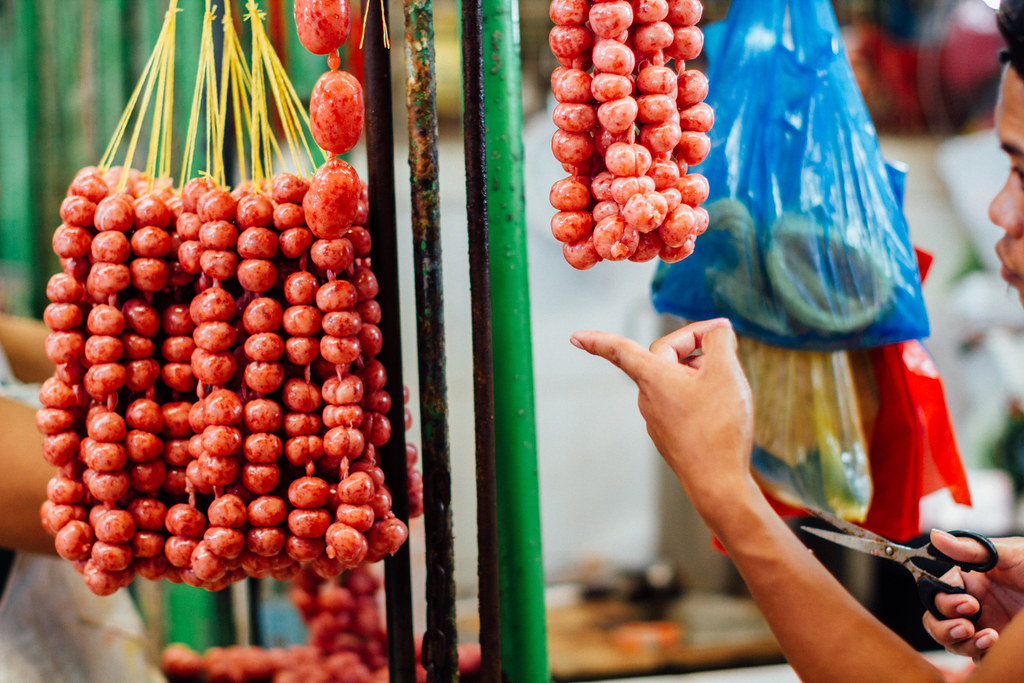Sai ua
A specialty of northern Thailand, sai ua is made from red curry paste and herbs like coriander, galangal, lemongrass and kaffir lime.
Every bite of this firm, dense sausage offers an intense flavour packed with heat and fragrance.
 Its Laotian equivalent, sai oua, contains similar ingredients, with an added umami punch from padaek or fermented fish sauce.
Its Laotian equivalent, sai oua, contains similar ingredients, with an added umami punch from padaek or fermented fish sauce.
To enjoy this spiced sausage like a true local, it must be eaten with nam phrik num (green roasted chili paste) and sticky rice.
Longganisa
During their colonial rule, the Spanish introduced their traditional sausages, longaniza and chorizo, to the Philippines.
While the Spanish differentiate between the two sausages, Filipinos use the terms longganisa and chorizo interchangeably, depending on the region.
 In most parts of Luzon, for instance, traditional sausages are called longganisa, while in the south, chorizo is the more common term.
In most parts of Luzon, for instance, traditional sausages are called longganisa, while in the south, chorizo is the more common term.
There are also different types of sausages unique to each region, such as Vigan longganisa with its chunks of garlic, oregano and paprika-flavoured Lucban longganisa, and chorizo de Macau, which contains anise-flavoured liqueur.
A popular way to enjoy longganisa is to have it with sinangag (garlic fried rice) and itlog (egg, usually fried), a hearty breakfast special called longsilog.
Cha lua
Vietnam is home to one of the most unique charcuterie traditions in Southeast Asia.
Although the Vietnamese learned how to make forcemeat from early French colonisers, they gave it a local spin with homegrown flavours like fish sauce and soya sauce, and wrapped their sausages in banana leaves.
 Sausage varieties abound in the country, but cha lua (also called gio lua) – made of pork, corn starch, garlic, ground pepper and fish sauce – is the most widely consumed.
Sausage varieties abound in the country, but cha lua (also called gio lua) – made of pork, corn starch, garlic, ground pepper and fish sauce – is the most widely consumed.
You can find cha lua in popular Vietnamese dishes like banh mi (Vietnamese sandwich) and banh cuon (steamed rice rolls), or just eaten as is with rice.
There are several varieties of sausage, such as cha bi, which adds pork skin for a bit of bite, and the peppercorn-filled cha Hue.
Kayah sausage
Kayah sausage is a famous product from the small landlocked state of Kayah in Myanmar.
Typically made from pork, this fiery snag is seasoned with garlic, salt, turmeric and andaliman pepper, which is similar to Sichuan pepper.
An all-natural meat product with no preservatives, this sundried sausage stays good for up to a week.
A source of pride for both the Kayah and Kayan ethnic communities, these sausages are usually fried and served with rice.
Urutan
There are several sausage variants originating in different parts of Indonesia.
From Bali comes the well-known urutan, a pork sausage made with classic Balinese seasonings like turmeric, coriander, blue ginger and sand ginger that give it a piquant, savoury flavour.
Urutan is typically eaten with rice and sambal matah or raw chili relish. It’s a must-have for traditional Balinese festivals like Galungan and Kuningan.
According to airasia.com














